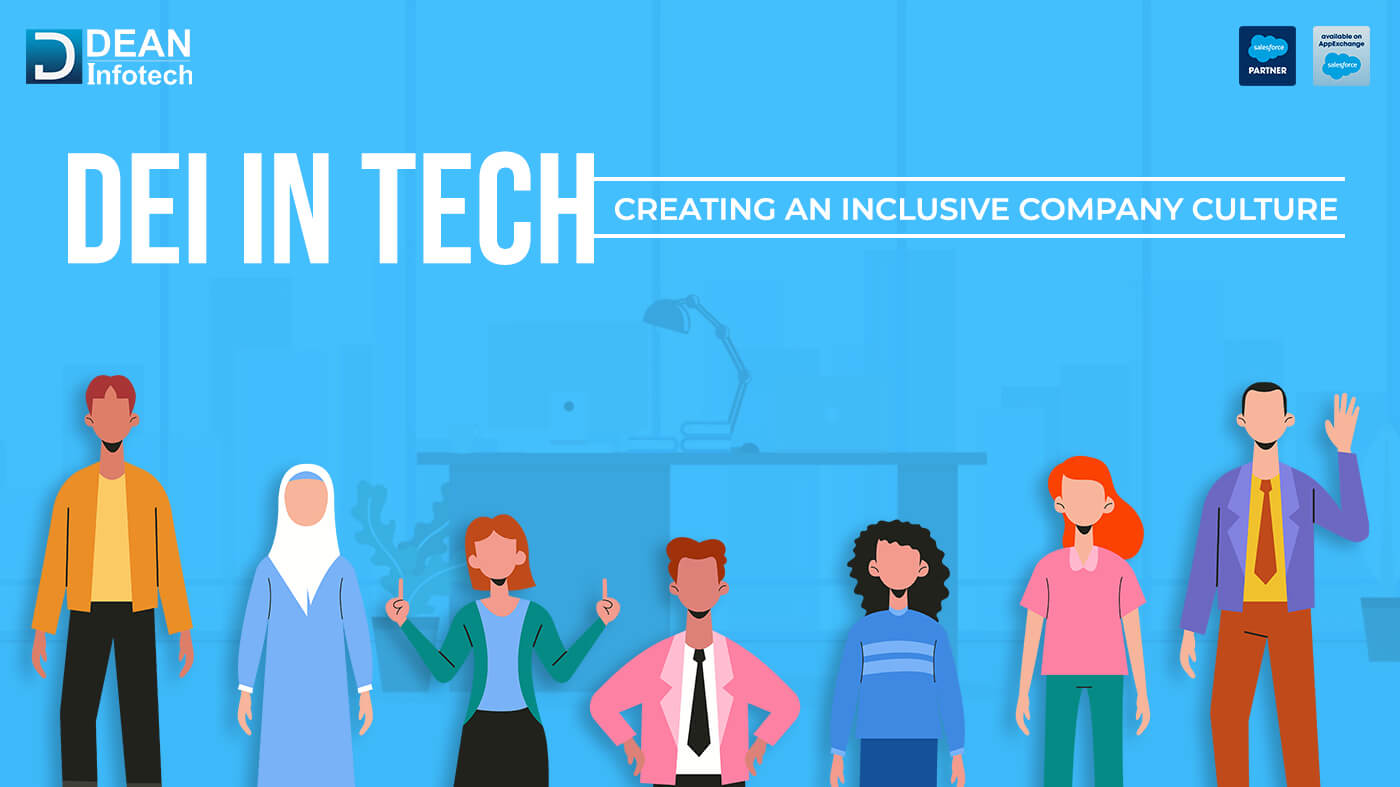DEI in Tech : Creating an Inclusive Company Culture
 Ankit Agarwal Monday, May 27, 2024
Ankit Agarwal Monday, May 27, 2024
In the modern corporate landscape, Diversity, Equity, and Inclusion (DEI) have become vital pillars in shaping progressive and sustainable work environments. DEI initiatives aim to foster a workplace where all individuals, regardless of their background, can thrive and contribute to their fullest potential.
- Diversity refers to the presence of differences within a given setting, encompassing aspects such as race, gender, age, sexual orientation, and cultural background. Embracing diversity enhances creativity and innovation by bringing varied perspectives to the table.
- Equity involves ensuring fair treatment, opportunities, and advancement while striving to identify and eliminate barriers that have prevented the full participation of some groups. Equity is about leveling the playing field, acknowledging that everyone starts from different places and requires different resources to achieve comparable outcomes.
- Inclusion is the practice of creating an environment where all individuals feel respected, accepted, and valued. It's about fostering a sense of belonging and ensuring that diverse voices are heard and considered in decision-making processes.
Corporations adopting DEI principles see improved employee satisfaction, better decision-making, and enhanced company performance. By embedding DEI into their core values, businesses not only cultivate a positive internal culture but also enhance their brand reputation, making them more attractive to top talent and socially conscious consumers.
Importance of DEI in the Tech Industry
The technology industry, known for its rapid innovation and dynamic growth, plays a crucial role in shaping the future. As this sector evolves, the importance of Diversity, Equity, and Inclusion (DEI) has become increasingly apparent. DEI initiatives are essential for fostering a culture that drives creativity, innovation, and sustainable success. Here are five key points highlighting the significance of DEI in the tech industry.
1. Enhancing Innovation and Creativity
Diverse teams bring varied perspectives and experiences to the table, which can lead to more innovative solutions and creative problem-solving. In the tech industry, where innovation is the cornerstone of success, having a workforce that reflects a wide range of backgrounds and ideas can result in the development of products and services that cater to a broader audience. Diverse perspectives help in identifying unique opportunities and tackling challenges from multiple angles, driving the industry forward.
2. Improving Product Design and User Experience
A diverse and inclusive team is more likely to create products that are accessible and relevant to a wide array of users. Understanding the needs and preferences of different demographic groups can lead to better product design and enhanced user experience. For instance, considering accessibility features for people with disabilities or designing with cultural sensitivities in mind ensures that technology serves everyone equitably. This not only broadens the market reach but also demonstrates a company’s commitment to social responsibility.
3. Attracting and Retaining Top Talent
Companies that prioritize DEI are more attractive to top talent. In an industry where skilled professionals are in high demand, creating an inclusive environment where everyone feels valued can be a significant competitive advantage. Employees are more likely to stay with a company where they see opportunities for growth and feel that their contributions are recognized and respected. A strong DEI culture fosters employee loyalty and reduces turnover, leading to a more stable and experienced workforce.
4. Driving Better Business Performance
Studies have shown that companies with diverse teams perform better financially. DEI initiatives can lead to improved decision-making, as diverse teams are better at assessing risks and identifying profitable opportunities. Inclusive companies often have higher employee engagement and satisfaction, which translates to increased productivity and better overall performance. In the tech industry, where the pace of change is rapid, having a diverse and engaged workforce can provide the agility needed to stay ahead of the competition.
5. Reflecting and Shaping Societal Values
The tech industry has a significant influence on society, not just through its products but also through the values it promotes. By embracing DEI, tech companies can lead by example, showing a commitment to equality and social justice. This not only enhances their brand reputation but also contributes to a more equitable society. Companies that advocate for DEI help set the standard for other industries and play a pivotal role in driving societal change.
Statistics and data on the current state of DEI in the tech sector.
The tech sector is a powerhouse of innovation, but how does it fare when it comes to diversity and inclusion? Let's dive into some eye-opening statistics:
1. Women in Tech: While growing, women hold only 26% of computing jobs in the US [Source: National Center for Women & Information Technology]. This underrepresentation translates to a vast pool of talent left untapped.
2. Leadership Lag: Only 7% of Fortune 500 CEOs are women, and even fewer are minorities [Source: Fortune]. This lack of diversity at the top hinders inclusive practices throughout the organization.
3. Missing Millennials: While the most diverse generation, only 37% of the tech workforce is of Millennials [Source: Pew Research Center]. This gap suggests a disconnect in attracting and retaining young talent.
4. The Pipeline Problem: Black and Hispanic workers make up just 8% and 9% of the tech workforce, respectively [Source: Bureau of Labor Statistics]. Educational and training initiatives are crucial to address this pipeline issue.
5. Retention Roadblock: People of color are more likely to leave tech jobs than white counterparts [Source: McKinsey & Company]. Fostering an inclusive culture is essential to retaining diverse talent.
6. Unconscious Bias: A whopping 80% of tech workers report experiencing bias in the workplace [Source: Blind]. Unconscious bias training can help mitigate this pervasive issue.
7. The Pay Gap: Women in tech earn 20% less than men in similar roles [Source: AAUW]. Ensuring pay equity is critical for achieving true inclusion.
8. The Promotion Plateau: Women and minorities are significantly underrepresented in leadership positions [Source: PwC]. Mentorship programs and clear promotion pathways can help bridge this gap.
9. The Innovation Imperative: Companies with diverse leadership teams experience 19% higher revenue [Source: Diversity Wins]. DEI is not just about fairness, it's about driving business success.
10. The Global Opportunity: The global tech talent pool is vast and diverse. By embracing international talent, companies can access a wider range of skills and perspectives to fuel innovation.
These statistics paint a complex picture. While progress is being made, there's a long way to go. By understanding these challenges and implementing effective DEI strategies, the tech sector can unlock its full potential and create a truly inclusive future.
Successful DEI Initiatives in Tech Companies
The statistics paint a clear picture: progress in DEI is happening, but there's a long way to go. However, many tech companies are taking concrete steps to create a more diverse, equitable, and inclusive workplace.
In this section, we'll delve deeper into five real-world examples. These case studies showcase successful DEI initiatives implemented by leading tech companies, offering valuable insights and inspiration for others to follow.
1. Salesforce: Trailblazer for Equality
Salesforce champions equality with initiatives like their "Equality Trailhead" learning platform, offering unconscious bias training and allyship resources. They also established an "Equality for All" venture fund to invest in diverse-led startups. These efforts have resulted in a workforce that's 42% women and 31% underrepresented minorities.
2. Microsoft: Building a Diverse Pipeline
Microsoft tackles the root causes of the diversity gap. Their "Microsoft Leap" program partners with community colleges to equip students, particularly women and minorities, with tech skills. This not only increases the talent pool but fosters a future workforce that reflects the communities they serve.
3. Intel: Unlocking Potential Through ERGs
Employee Resource Groups (ERGs) are a powerful tool for inclusion. Intel boasts a robust ERG network, providing support, networking opportunities, and mentorship programs for underrepresented groups. This fosters a sense of belonging and empowers employees to thrive.
4. Pinterest: Redefining Leadership
Pinterest prioritizes diversity at the leadership level. Their board of directors is 40% women and 40% people of color, exceeding industry averages. This sets a strong tone for inclusivity and inspires employees from all backgrounds to pursue leadership roles.
5. Adobe: Championing Accessibility
Accessibility is a key aspect of inclusion. Adobe prioritizes accessible product design and development, ensuring their technology is usable by everyone. They also actively recruit talent with disabilities, fostering a diverse and innovative workforce.
These are just a few examples of how tech companies are making progress in DEI. By implementing similar initiatives and fostering a culture of inclusion, the tech sector can unlock its full potential and create a more equitable future.
The Role of Leadership in Promoting DEI
Leadership plays a crucial role in advancing Diversity, Equity, and Inclusion (DEI) within organizations. Effective leaders drive cultural change, establish accountability, and ensure that DEI initiatives are integrated into all aspects of the business. Here are several key ways in which leadership can promote DEI:
1. Setting the Tone from the Top
Leaders must visibly and vocally champion DEI values. When top executives prioritize DEI, it sends a clear message throughout the organization that these principles are critical to the company’s success. This commitment can be demonstrated through speeches, participation in DEI events, and public statements that underscore the importance of diversity and inclusion .
2. Establishing Clear Policies and Practices
Leaders are responsible for developing and implementing policies that promote diversity and prevent discrimination. This includes creating inclusive hiring practices, establishing equitable pay structures, and ensuring that there are clear, enforceable policies against harassment and discrimination. These policies must be communicated effectively and applied consistently across the organization.
3. Fostering an Inclusive Culture
Creating an inclusive culture requires leaders to actively promote an environment where all employees feel valued and respected. This involves encouraging open dialogue, celebrating diverse perspectives, and providing platforms for underrepresented groups to voice their experiences and concerns. Leaders can foster inclusivity by implementing training programs that address unconscious bias and by setting up employee resource groups.
4. Accountability and Measurement
Leaders must hold themselves and their organizations accountable for progress in DEI. This involves setting measurable goals, tracking progress, and transparently reporting on outcomes. Regular assessments and audits can help identify areas for improvement and ensure that DEI initiatives are effective. Leaders should be open to feedback and willing to adjust strategies as needed to meet their DEI objectives.
5. Promoting Diverse Leadership
To truly advance DEI, it is essential to ensure that leadership teams themselves are diverse. This includes not only racial and gender diversity but also diversity in thought, background, and experience. Diverse leadership teams are better equipped to understand and address the needs of a varied workforce and customer base. Leaders should mentor and sponsor diverse talent within the organization to prepare them for leadership roles (Techopedia) (DOIT).
6. Integrating DEI into Business Strategy
DEI should be integrated into the core business strategy, not treated as an isolated initiative. This means considering diversity in every aspect of the business, from product development to marketing and customer service. Leaders should ensure that DEI principles are embedded in the company’s mission, values, and strategic goals.
Navigating DEI Challenges Work Environment
While the tech industry has made strides in diversity, equity, and inclusion (DEI), there are still significant challenges to overcome. Creating an inclusive company culture requires proactive effort and a willingness to address systemic issues head-on. Here are some common DEI challenges in tech workplaces, and strategies to navigate them:
1. Lack of Representation:
The Challenge: Tech companies often lack diversity at all levels, particularly in leadership positions. This can create a sense of isolation for underrepresented groups and hinder their career advancement.
Strategies:
- Implement diverse hiring practices, including blind resume reviews and diverse interview panels.
- Offer mentorship and sponsorship programs for underrepresented employees.
- Set clear diversity goals and track progress regularly.
2. Unconscious Bias:
The Challenge: Unconscious biases can affect hiring, promotions, and everyday interactions, often disadvantaged individuals from underrepresented groups.
Strategies:
- Provide mandatory unconscious bias training for all employees.
- Encourage inclusive language and behaviors.
- Implement structured decision-making processes to reduce the impact of bias.
3. Microaggressions:
The Challenge: Subtle, often unintentional comments or actions can create a hostile environment for underrepresented employees.
Strategies:
- Foster a culture of open communication where employees feel safe reporting microaggressions.
- Educate employees about microaggressions and their impact.
- Hold individuals accountable for their behavior.
4. Lack of Inclusive Policies:
The Challenge: Company policies may not adequately address the needs of diverse employees, leading to inequalities.
Strategies:
- Review and revise policies to ensure they are inclusive, such as flexible work arrangements and parental leave policies.
- Seek feedback from diverse employees on how policies can be improved.
- Establish employee resource groups (ERGs) to provide support and community.
5. Resistance to Change:
The Challenge: Some employees may resist DEI efforts due to discomfort, lack of understanding, or fear of change.
Strategies:
- Communicate the benefits of DEI for the company and its employees.
- Provide opportunities for education and dialogue around DEI topics.
- Celebrate successes and highlight positive changes resulting from DEI initiatives.
Building Diverse Teams: Benefits and Strategies
A diverse team isn't just a checkbox for DEI – it's a powerful asset that drives innovation, problem-solving, and overall company success. In the tech industry, where creativity and new ideas are paramount, diversity of thought becomes a key differentiator.
Benefits of Diverse Teams:
1. Enhanced Innovation: People from different backgrounds bring unique perspectives and approaches to the table. This diversity of thought fuels creativity and leads to more innovative solutions.
2. Improved Problem-Solving: A wider range of experiences and viewpoints allows teams to anticipate challenges and develop more effective solutions.
3. Increased Employee Engagement: When employees feel valued for their unique contributions, they're more engaged and motivated, leading to higher productivity and retention rates.
4. Stronger Decision-Making: Diverse teams consider a broader range of options, reducing the risk of groupthink and leading to more well-rounded decisions.
5. Expanded Market Reach: A diverse workforce better understands and connects with a diverse customer base, leading to increased market share and profitability.
6. Enhanced Brand Reputation: Companies known for their inclusive cultures are more attractive to top talent and customers alike.
Strategies for Building Diverse Teams:
1. Intentional Recruitment:
- Broaden your talent pool by sourcing candidates from diverse backgrounds and underrepresented groups.
- Implement blind resume reviews to reduce unconscious bias in the initial screening process.
- Use diverse interview panels to ensure a fair and equitable evaluation of candidates.
2. Inclusive Onboarding and Training:
- Create an onboarding experience that welcomes and values diversity.
- Provide ongoing training on unconscious bias, microaggressions, and inclusive communication.
- Foster a culture of open dialogue where employees feel comfortable sharing their perspectives and experiences.
3. Mentorship and Sponsorship Programs:
- Establish mentorship programs to provide guidance and support to underrepresented employees.
- Create sponsorship programs to advocate for the career advancement of diverse talent.
4. Employee Resource Groups (ERGs):
- Encourage the formation of ERGs to provide a sense of community and belonging for underrepresented groups.
- Support ERGs in their efforts to promote diversity and inclusion within the company.
5. Data-Driven Decision Making:
- Track diversity metrics to identify areas for improvement.
- Use data to inform hiring, promotion, and development decisions.
- Regularly assess the effectiveness of DEI initiatives and make adjustments as needed.
Conclusion
The journey towards a diverse, equitable, and inclusive (DEI) culture in the tech industry is not just a moral imperative but a strategic necessity. By fostering an environment where all employees feel valued and included, tech companies can drive innovation, improve employee satisfaction, and enhance business performance. Leadership plays a critical role in this transformation, setting the tone from the top and embedding DEI into every aspect of the organization.
Effective DEI initiatives require clear policies, consistent accountability, and a commitment to measurable goals. Diverse leadership teams are essential to understanding and addressing the varied needs of a global workforce and customer base. Moreover, integrating DEI into the core business strategy ensures that these principles are not isolated efforts but fundamental components of the company's mission and values.
As tech companies continue to evolve, embracing DEI is crucial for attracting and retaining top talent, fostering creativity, and maintaining a competitive edge. By prioritizing DEI, the tech industry can lead the way in creating workplaces that reflect and celebrate the diversity of the communities they serve, ultimately contributing to a more equitable and inclusive society.
Creating an inclusive company culture in tech is a continuous process that demands dedication and action at all levels. As organizations commit to this path, they not only build stronger, more resilient businesses but also help shape a future where everyone has the opportunity to succeed.








Comment